消息中间件RabbitMQ的原理和使用
一、什么是MQ
MQ是MessageQueue的简写,表示消息队列的意思,它是一种用于在应用程序之间传递消息的技术。多用于分布式系统之间进行通信,作为消息中间件使用。MQ的作用有应用解耦、异步提速、流量削峰填谷,当然也有缺点,加入MQ消息中间件会额外增加系统的外部依赖,是系统稳定性降低,同时也增加系统的复杂度。
消息队列,是基础数据结构中“先进先出”的一种数据结构。指把要传输的数据(消息)放在队列中,用队列机制来实现消息传递——生产者产生消息并把消息放入队列,然后由消费者去处理。消费者可以到指定队列拉取消息,或者订阅相应的队列,由MQ服务端给其推送消息。
目前主流的作为消息中间件的产品有ActiveMQ、RabbitMQ、Kafka、RocketMQ等开源产品。其产品各有特点,对比如下:
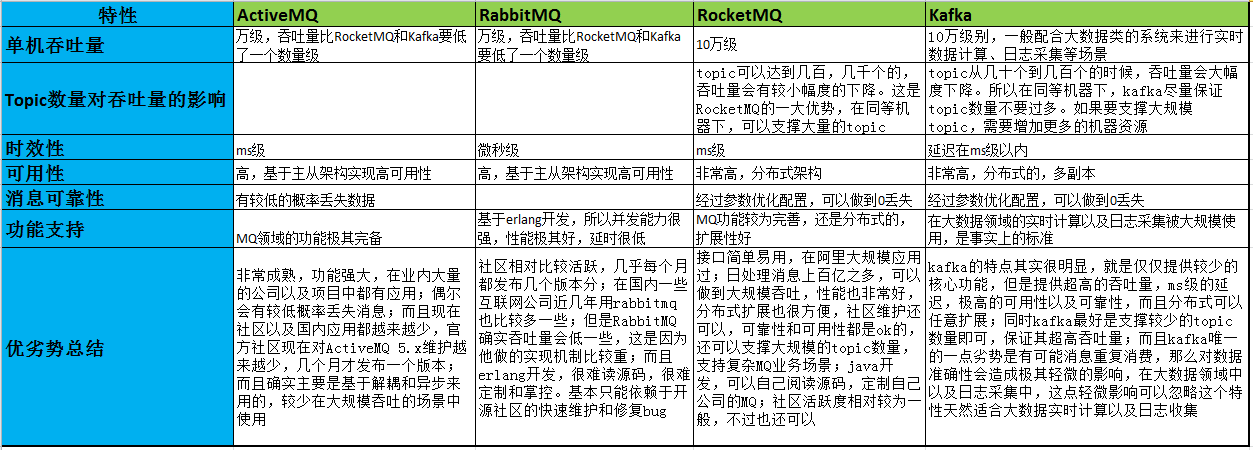
二、什么是RabbitMQ
RabbitMQ 是一款开源的基于 AMQP协议模型的消息中间件,是一个由 Erlang 语言开发的 AMQP 的开源实现,具有高可用、可扩展、易用性、跨平台支持和多种协议兼容性等特点。其架构模型与 AMQP协议模型完全一致,如下:
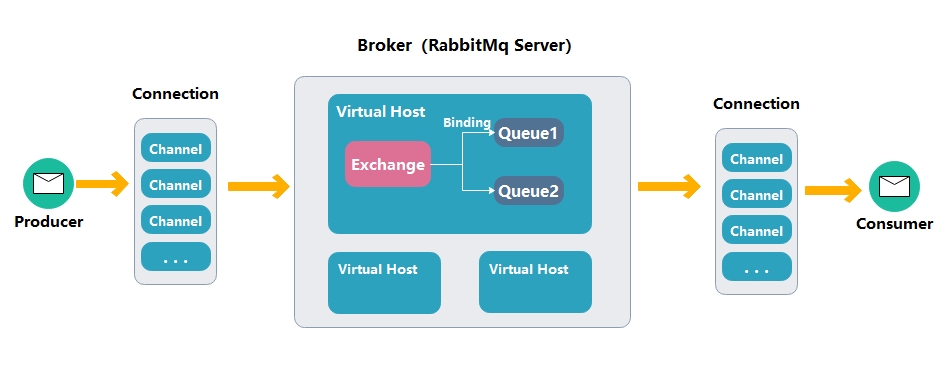
RabbitMQ 共有七种工作模式:
- Simple(简单模式):使用direct交换机,一个生产者对应一个消费者。

- Work Queue(工作队列模式):使用direct交换机,一个生产者对应多个消费者。这些消费者之间形成竞争关系,一条消息只能被消费一次,默认采用轮询的方式将消息发送给消费者。
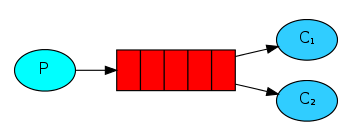
- Publish/Subscribe(发布订阅模式):使用fanout交换机,一个交换机会将收到的消息发布到绑定到该交换机的所有队列中,然后再分发给不同的消费者。
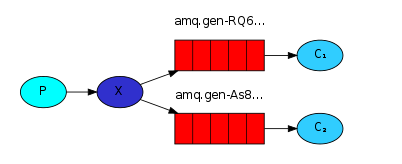
- Routing(路由模式):使用direct交换机,生产者将带有RoutingKey 的消息发送给交换机,交换机根据队列绑定的RoutingKey分发消息到指定的队列。

- Topics(通配符模式):使用topic交换机,功能与路由模式相似,但支持通配符路由,允许模糊匹配RoutingKey绑定匹配队列。

- Headers(请求头模式):使用headers交换机,该模式下取消了routingkey,使用header中的 key/value(键值对)匹配队列。
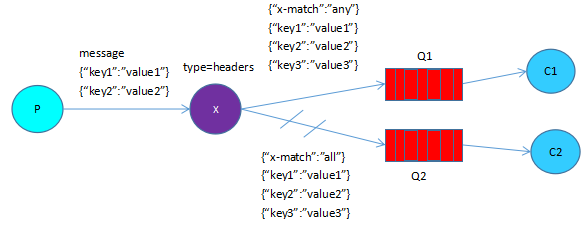
- RPC(远程调用模式):一个服务器调用另一个服务器的方法,该方式不常用。
三、RabbitMQ的可靠性投递和消息确认机制
消息的可靠性投递指的是从生产者-交换机-队列-消费者的每一个环节都要成功,RabbitMQ在每一步都提供了消息确认机制来保证消息的可靠性传递,除该机制外RabbitMQ还使用事务机制来保证消息的可靠性,但事务机制效率极低,不推荐使用。以下是消息确认机制的原理:

从图中的4个步骤一一分析:
- 生产者发送消息到Broker后,如何确保消息已经正确的投递到交换机?Broker会给生产者返回一个应答Confirm来告知消息是否已经投递到交换机,生产者使用ConfirmListener监听器来获取Confirm,投递成功时handleAck方法被回调,投递失败时handleNack方法被回调。
- 投递到交换机的消息如何确保已经被正确的投递到队列?当正确的投递到队列时Broker则不做任何返回,当消息不能正确的路由到队列时,Broker会返回一个应答Return来告知生产者,生产者使用ReturnListener监听器来获取Return,监听器的handleReturn方法被回调,我们在该方法中做逻辑处理。
- 消息到达队列后如何保证消息不丢失?通过开启交换机持久化、队列持久化、消息持久化可以保证突然断电等情况导致的内存数据丢失。
- 消息从队列投递到消费者,如何保证消费者已经正确的处理了消息?使用消费者的手动确认机制,采用该机制时Broker会等待消费者显示的回复确认信号后才会从队列中删除消息。如果使用消费者自动确认机制,则只要消费者收到消息后就会告知Broker已正确处理信息,消息将被Broker删除。
四、RabbitMQ的死信交换机
当一个队列中的消息满足如下条件时则被成为死信,如果队列配置了 dead-letter-exchange属性,则这些死信会被投递到dead-letter-exchange指定的交换机,从而这个交换机被称为死信交换机。死信的条件:
- 消费者使用 basic.reject 或 basic.nack 声明消费失败,并且消息的 requeue 参数设置为 false。
- 消息时一个过期消息,超时无人消费。
- 要投递的队列消息堆满了,最早的消息可能成为死信。
使用死信交换机可以隔离这些不被正确处理的消息,将其放到一个特殊的队列中做特殊处理,从而减少整个消息系统的运行阻碍时间。
五、延迟队列的使用
延迟队列中的消息不会马上消费,需要等待指定的时间以后才能被消费,它的作用是用于延迟处理消息,比如购买东西时有下单30分钟内未支付则取消订单的需求,此情况下可以让订单消息等待30分钟后再去消费,判断是否支付,如果未支付则需要回滚库存等,这类似于定时器的功能。
RabbitMQ本身没有提供延迟队列的功能,但是可以通过TTL过期时间和死信队列来实现延迟队列。TTL指的是消息存活时间,当然队列也有存活时间。实现原理是设置消息、队列过期时间,不去消费这些消息,等待消息过期后加入到死信队列,通过一个特殊的消费者来专门处理这些消息,就可以实现类似延迟队列的功能。
六、消息的幂等性
幂等性是指对于同一个资源,无论请求多少次,对该资源本身造成的影响应该是相等的,不应该出现重复的请求而对资源重复造成影响。消息消费时的幂等性指的是消息不被重复消费,例如接口幂等性也是一样,同样参数调用同样接口不会造成业务错误。
如何避免消息的重复消费是必须考虑的问题,主流的幂等性处理方式有2种:
- 消息全局 ID :消费消息之前根据 ID 判断该消息是否已消费过,如果已经消费过,则不处理。
- Redis的setnx命令:给消息分配一个全局 ID,消费该消息时,先去 Redis 中查询有没消费记录。
七、RabbitMQ的安装
rabbitMQ有不同的版本,可以安装到windows、linux、mac等系统中,安装方式包括docker安装、源码安装、安装包方式等,由于是基于Erlang语言开发,因此除docker方式外其他方式基本都需要先安装Erlang环境。
以Ubuntu系统docker方式安装为例,命令如下:
1 | docker run -dit --name rabbitmq --restart=always -e RABBITMQ_DEFAULT_USER=admin -e RABBITMQ_DEFAULT_PASS=admin -p 15672:15672 -p 5672:5672 rabbitmq:management |
通过上面的命令可以看到两个端口15672、5672,前者是RabbitMQ可视化界面的web访问端口,后者是生产者和消费者连接RabbitMQ用到的端口。安装完成后访问IP+15672得到如下界面,即为安装成功。


八、Java—RabbitMQClient快速开发包
以maven项目为例,通过引入com.rabbitmq包,可以快速的开发生产者和消费者,首先引入依赖。
1 2 3 4 5 | <dependency> <groupId>com.rabbitmq</groupId> <artifactId>amqp-client</artifactId> <version>5.7.2</version></dependency> |
在编写代码之前,应该了解com.rabbitmq封装的如下几个重要对象:
1、ConnectionFactory:简单工厂类,用于创建到RabbitMQ中间件的连接,该步骤包括建立TCP连接、数据发送、异常处理、心跳检测等,该类使用具有多个重载的newConnection方法创建AMQConnection实例,可配置常用属性如下:
- host:RabbitMQ服务器主机。
- port:RabbitMQ服务器端口,默认5672。
- username:RabbitMQ用户名。
- password:RabbitMQ密码。
- virtualHost:虚拟主机,默认虚拟主机为"/"。
- connectionTimeout:TCP连接超时等待时间。
- shutdownTimeout:关闭超时,默认是10s,如果是0则无限等待。
- automaticRecovery:启用或禁用自动连接恢复。
- networkRecoveryInterval:设置连接恢复间隔。
- requestedChannelMax:最大通道数。
- requestedFrameMax:请求帧大小,默认0表示不限制。
- requestedHeartbeat:心跳检测间隔,默认是60s。
- handshakeTimeout:握手超时,默认是10s
- exceptionHandler:异常处理器,建立连接异常时被调用。
- metricsCollector:rabbitmq消息监控收集器。
- channelRpcTimeout:通道超时时间,默认为10分钟。
- errorOnWriteListener:监听器,当连接在套接字上写入出现IO错误时被调用。
2、AMQConnection:实现了Connection接口,表示到RabbitMQ中间件的AMQP连接的具体类。该类提供了销毁/关闭连接、创建信道、添加连接阻塞情况监听器的方法:
- createChannel:创建信道。
- openChannel:创建信道。
- abort:销毁连接。
- close:关闭连接。
- addBlockedListener:添加连接阻塞情况监听器。
3、AMQChannel:实现了Channel接口,表示一个传输通道,一个Connecton可以包含多个传输通道。该类提供了关闭/销毁信道、添加各类监听器、绑定交换机、队列、发送消息等方法:
- abort:销毁此信道。
- close:关闭此信道。
- confirmSelect:在该信道上启用消息的发布者确认。消息确认是指生产者发布消息到Broker,Broker收到消息后会给生产者一个应答Confirm ,生产者接收Confirm来判断消息是否正常送达交换机。
- addConfirmListener:添加ConfirmListener,该监听器用于监听Broker收到消息后返回的Confirm。ConfirmListener包含两个方法handleAck(投递成功时回调)、handleNack(投递失败时回调)。
- addReturnListener:添加ReturnListener,该监听器用于监听不能正确路由到队列的消息。当消息不能从交换机投递到队列时,Broker会返回一个应答Return,此时监听器的handleReturn方法会被回调,可以在该方法中对路由失败的消息进行后续处理(前提是配置Mandatory参数为true,如果配置为false,则Broker端会自动删除该消息)。
- addShutdownListener:添加ShutdownListener,该监听器用于监听信道关闭,当信道关闭时该监听器的shutdownCompleted方法会执行。
- basicConsume:开启一个消费者来监听指定队列的消息。
- basicPublish:消息发布。
- exchangeBind:绑定交换机。
- exchangeDeclare:声明一个交换机。
- queueBind:将队列绑定到交换机。
- queueDeclare:声明队列。
- basicQos:设置服务器的限流策略,该方法有三个参数prefetchSize(服务器将提供的最大内容量)、prefetchCount(服务器将传递的最大消息数)、global(设置是否应用于整个通道)。
- exchangeDelete:删除交换机。
- exchangeUnbind:解绑交换机。
- queueDelete:删除队列。
- queueUnbind:取消队列与交换机的绑定。
- queuePurge:清除给定队列的内容。
- basicAck:肯定性的消息确认,表示消息已经被正确处理,Broker可以删除该消息了。
- basicReject:否定性的消息确认,告诉Broker不要再发送该消息了。
- basicNack:否定性的消息确认,表示消息没有被正确处理,Broker需要重新发送消息。
- basicCancel:取消消费者的消费,停止监听队列的消息。
- basicRecover:重新发送未确认的消息。
- basicGet:使用AMQP从队列中检索消息。
- txSelect:启用 TX事务模式。
- txRollback:回滚事务。
- txCommit:提交事务。
- setDefaultConsumer:设置默认消费者。
- rpc:远程方法调用。
九、RabbitMQ-Client使用示例代码
1、消费者端代码:根据前面介绍的工作模式发现,消费者端无需和交换机打交道,消费消息只需要指定队列即可,因此简单模式、路由模式、主题模式、工作队列模式的消费者代码一致的。

1 package org.rmq; 2 3 4 import com.rabbitmq.client.*; 5 6 import java.io.IOException; 7 import java.nio.charset.StandardCharsets; 8 import java.util.concurrent.TimeoutException; 9 10 /** 11 * 消费者代码 消费者端与交换机无关,只需要绑定消费队列监听即可 因此简单模式、路由模式、主题模式、工作队列模式的消费者代码一致 12 * @author zmy 13 */ 14 public class ConsumerClient { 15 public static void main(String[] args) throws IOException, TimeoutException { 16 // 创建连接工厂 17 ConnectionFactory connectionFactory = new ConnectionFactory(); 18 connectionFactory.setHost("192.168.1.101"); 19 connectionFactory.setPort(5672); 20 connectionFactory.setUsername("admin"); 21 connectionFactory.setPassword("admin"); 22 connectionFactory.setVirtualHost("/"); 23 24 // 创建连接 25 Connection conn = connectionFactory.newConnection(); 26 27 //创建通道 28 Channel channel = conn.createChannel(); 29 30 //实例化一个监听器 31 Consumer consumer = new DefaultConsumer(channel) { 32 33 /** 34 * 当接收到消息后,此方法将被调用 35 * @param consumerTag 消费者标签,在监听队列时设置channel.basicConsume 36 * @param envelope 信封,可从中获取消息id,消息routingkey,交换机,消息和重试标志 37 * @param properties 属性信息 38 * @param body 消息 39 * @throws IOException 40 */ 41 @Override 42 public void handleDelivery(String consumerTag, Envelope envelope, AMQP.BasicProperties properties, byte[] body) throws IOException { 43 //路由key 44 System.out.println("路由key为:" + envelope.getRoutingKey()); 45 //交换机 46 System.out.println("交换机为:" + envelope.getExchange()); 47 //消息id 48 System.out.println("消息id为:" + envelope.getDeliveryTag()); 49 //收到的消息 50 System.out.println("接收到的消息为:" + new String(body, StandardCharsets.UTF_8)); 51 52 //手动确认消息 确认方式有三种 53 //channel.basicReject(envelope.getDeliveryTag(), false); 54 //channel.basicNack(envelope.getDeliveryTag(), false, false); 55 channel.basicAck(envelope.getDeliveryTag(), false); 56 } 57 }; 58 59 /** 60 *开启监听器监听消息 61 *1. queue 队列名称 62 *2. autoAck 自动回复,当消费者接收到消息后要告诉mq消息已接收,如果将此参数设置为ture表示会自动回复mq,如果设置为false要通过编程实现回复 63 *3. callback 消费消息的方法,消费者接收到消息要回调该方法 64 */ 65 channel.basicConsume("TopicModelQueue1", false, consumer); 66 channel.basicConsume("TopicModelQueue2", false, consumer); 67 channel.basicConsume("PublishSubscribeModelQueue1", false, consumer); 68 channel.basicConsume("PublishSubscribeModelQueue2", false, consumer); 69 channel.basicConsume("RouteModelQueue1", false, consumer); 70 channel.basicConsume("RouteModelQueue2", false, consumer); 71 channel.basicConsume("WorkQueueModelQueue", false, consumer); 72 channel.basicConsume("SimpleModelQueue", false, consumer); 73 //不关闭连接可以保证客户端一直接收消息 74 //channel.close(); 75 //conn.close(); 76 } 77 }
2、工作队列模式和简单模式的生产者代码也是一样的,唯一的区别是前者具有多个消费者,形成消息竞争关系,后者只有一个消费者。

1 package org.rmq; 2 3 import com.rabbitmq.client.Channel; 4 import com.rabbitmq.client.Connection; 5 import com.rabbitmq.client.ConnectionFactory; 6 7 import java.io.IOException; 8 import java.util.concurrent.TimeoutException; 9 10 11 public class SimpleProducerClient { 12 public static void main(String[] args) throws IOException, TimeoutException { 13 14 // 创建连接工厂 15 ConnectionFactory connectionFactory = new ConnectionFactory(); 16 connectionFactory.setHost("192.168.1.101"); 17 connectionFactory.setPort(5672); 18 connectionFactory.setUsername("admin"); 19 connectionFactory.setPassword("admin"); 20 connectionFactory.setVirtualHost("/"); 21 22 // 创建连接 23 Connection conn = connectionFactory.newConnection(); 24 25 //创建通道 26 Channel channel = conn.createChannel(); 27 28 //默认就是直连交换机,无需显示声明 29 //channel.exchangeDeclare("SimpleModelExchange", "direct", true); 30 31 /** 32 * 声明队列 33 * 参数1:队列名称 34 * 参数2:是否持久化 35 * 参数3:是否独占本连接 36 * 参数4:是否自动删除 37 * 参数5:其他参数 38 */ 39 channel.queueDeclare("SimpleModelQueue", true, false, false, null); 40 41 /** 42 * 发送消息 43 * 参数1:交换机名称,如果没有则指定空字符串(默认交换机) 44 * 参数2:路由key,简单模式可以指定队列名称 45 * 参数3:消息其他属性 46 * 参数4:消息内容 47 */ 48 channel.basicPublish("", "SimpleModelQueue", null, "我是通过简单模式传递的消息!".getBytes()); 49 50 channel.close(); 51 conn.close(); 52 53 } 54 55 56 }
3、路由模式生产者代码:使用路由键绑定队列,通过路由键发送消息相应队列。

1 package org.rmq; 2 3 import com.rabbitmq.client.BuiltinExchangeType; 4 import com.rabbitmq.client.Channel; 5 import com.rabbitmq.client.Connection; 6 import com.rabbitmq.client.ConnectionFactory; 7 8 import java.io.IOException; 9 import java.util.concurrent.TimeoutException; 10 11 12 public class RouteProducerClient { 13 public static void main(String[] args) throws IOException, TimeoutException { 14 15 // 创建连接工厂 16 ConnectionFactory connectionFactory = new ConnectionFactory(); 17 connectionFactory.setHost("192.168.1.101"); 18 connectionFactory.setPort(5672); 19 connectionFactory.setUsername("admin"); 20 connectionFactory.setPassword("admin"); 21 connectionFactory.setVirtualHost("/"); 22 23 // 创建连接 24 Connection conn = connectionFactory.newConnection(); 25 26 //创建通道 27 Channel channel = conn.createChannel(); 28 29 /** 需要显示的声明交换机 类型为direct 30 * 参数1:交换机名称 31 * 参数2:交换机类型 32 * 参数3:是否持久化 33 * 参数4:是否自动删除 34 * 参数5:其他参数 35 */ 36 channel.exchangeDeclare("directExchange01", BuiltinExchangeType.DIRECT,true,false,null); 37 38 /** 39 * 声明队列 40 * 参数1:队列名称 41 * 参数2:是否持久化 42 * 参数3:是否独占本连接 43 * 参数4:是否自动删除 44 * 参数5:其他参数 45 */ 46 channel.queueDeclare("RouteModelQueue1", true, false, false, null); 47 channel.queueDeclare("RouteModelQueue2", true, false, false, null); 48 49 50 /** 51 * 将队列和交换机绑定,此方式需要设置routingKey 52 * 如下表示key1键匹配了RouteModelQueue1、RouteModelQueue2,key2键匹配了RouteModelQueue2 53 * 只有生产者发送的消息的routingKey和队列的routingKey一致时,消息才能被该队列接收 54 */ 55 channel.queueBind("RouteModelQueue1", "directExchange01", "key1"); 56 channel.queueBind("RouteModelQueue2", "directExchange01", "key1"); 57 channel.queueBind("RouteModelQueue2", "directExchange01", "key2"); 58 59 /** 60 * 发送消息 61 * 参数1:交换机名称,如果没有则指定空字符串(默认交换机) 62 * 参数2:路由key, 本例中设置为"key1",这消息会被发送到队列RouteModelQueue1和RouteModelQueue2,因为key1在前面绑定到了这两个队列 63 * 参数3:消息其他属性 64 * 参数4:消息内容 65 */ 66 channel.basicPublish("directExchange01", "key1", null, "我是通过路由模式模式匹配key1传递的消息!".getBytes()); 67 68 channel.basicPublish("directExchange01", "key2", null, "我是通过路由模式模式匹配key2传递的消息!".getBytes()); 69 70 channel.close(); 71 conn.close(); 72 73 } 74 75 76 }
4、主题模式生产者代码:与路由模式相似,只不过是交换机类型不同,而且主题模式使用路由键通配符模糊匹配。

package org.rmq; import com.rabbitmq.client.BuiltinExchangeType; import com.rabbitmq.client.Channel; import com.rabbitmq.client.Connection; import com.rabbitmq.client.ConnectionFactory; import java.io.IOException; import java.util.concurrent.TimeoutException; public class TopicsProducerClient { public static void main(String[] args) throws IOException, TimeoutException { // 创建连接工厂 ConnectionFactory connectionFactory = new ConnectionFactory(); connectionFactory.setHost("192.168.1.101"); connectionFactory.setPort(5672); connectionFactory.setUsername("admin"); connectionFactory.setPassword("admin"); connectionFactory.setVirtualHost("/"); // 创建连接 Connection conn = connectionFactory.newConnection(); //创建通道 Channel channel = conn.createChannel(); /** 需要显示的声明交换机 类型为topic * 参数1:交换机名称 * 参数2:交换机类型 * 参数3:是否持久化 * 参数4:是否自动删除 * 参数5:其他参数 */ channel.exchangeDeclare("topicExchange01", BuiltinExchangeType.TOPIC,true,false,null); /** * 声明队列 * 参数1:队列名称 * 参数2:是否持久化 * 参数3:是否独占本连接 * 参数4:是否自动删除 * 参数5:其他参数 */ channel.queueDeclare("TopicModelQueue1", true, false, false, null); channel.queueDeclare("TopicModelQueue2", true, false, false, null); /** * 将队列和交换机绑定,此方式需要设置routingKey * routingKey以通配符的方式绑定 :使用#或者*进行匹配 */ channel.queueBind("TopicModelQueue1", "topicExchange01", "error.*"); channel.queueBind("TopicModelQueue2", "topicExchange01", "info.*"); channel.queueBind("TopicModelQueue2", "topicExchange01", "*.warn"); /** * 发送消息 * 参数1:交换机名称,如果没有则指定空字符串(默认交换机) * 参数2:路由key : 该key会与绑定队列时传递的通配符routingKey进行匹配,若匹配成功则投递消息到对应的队列。例如下面第一个消息会被投递到 * TopicModelQueue1队列中,第二个消息会被投递到TopicModelQueue2队列中。第三个消息会投递TopicModelQueue2队列中。 * 参数3:消息其他属性 * 参数4:消息内容 */ channel.basicPublish("topicExchange01", "error.001", null, "我是通过主题模式模糊匹配error传递的消息!".getBytes()); channel.basicPublish("topicExchange01", "info.log", null, "我是通过主题模式模糊匹配info.log传递的消息!".getBytes()); channel.basicPublish("topicExchange01", "ms.warn", null, "我是通过主题模式模糊匹配ms.warn传递的消息!".getBytes()); channel.close(); conn.close(); } }
5、发布订阅模式生产者代码:使用fanout交换机,无须绑定路由键,消息会被发送到所有绑定到交换机的队列。

1 package org.rmq; 2 3 import com.rabbitmq.client.BuiltinExchangeType; 4 import com.rabbitmq.client.Channel; 5 import com.rabbitmq.client.Connection; 6 import com.rabbitmq.client.ConnectionFactory; 7 8 import java.io.IOException; 9 import java.util.concurrent.TimeoutException; 10 11 12 public class PublishSubscribeProducerClient { 13 public static void main(String[] args) throws IOException, TimeoutException { 14 15 // 创建连接工厂 16 ConnectionFactory connectionFactory = new ConnectionFactory(); 17 connectionFactory.setHost("192.168.1.101"); 18 connectionFactory.setPort(5672); 19 connectionFactory.setUsername("admin"); 20 connectionFactory.setPassword("admin"); 21 connectionFactory.setVirtualHost("/"); 22 23 // 创建连接 24 Connection conn = connectionFactory.newConnection(); 25 26 //创建通道 27 Channel channel = conn.createChannel(); 28 29 /** 需要显示的声明交换机 类型为fanout 30 * 参数1:交换机名称 31 * 参数2:交换机类型 32 * 参数3:是否持久化 33 * 参数4:是否自动删除 34 * 参数5:其他参数 35 */ 36 channel.exchangeDeclare("fanoutExchange01", BuiltinExchangeType.FANOUT,true,false,null); 37 38 /** 39 * 声明队列 40 * 参数1:队列名称 41 * 参数2:是否持久化 42 * 参数3:是否独占本连接 43 * 参数4:是否自动删除 44 * 参数5:其他参数 45 */ 46 channel.queueDeclare("PublishSubscribeModelQueue1", true, false, false, null); 47 channel.queueDeclare("PublishSubscribeModelQueue2", true, false, false, null); 48 49 50 // 将队列和交换机绑定,此方式不携带路由信息,不使用路由匹配 51 channel.queueBind("PublishSubscribeModelQueue1", "fanoutExchange01", ""); 52 channel.queueBind("PublishSubscribeModelQueue2", "fanoutExchange01", ""); 53 54 55 /** 56 * 发送消息 57 * 参数1:交换机名称,如果没有则指定空字符串(默认交换机) 58 * 参数2:路由key,消息会被发送到指定路由key的队列中 因为是fanout模式,所以这里不写路由,表示会发送到所有与该交换机绑定的队列中 59 * 参数3:消息其他属性 60 * 参数4:消息内容 61 */ 62 channel.basicPublish("fanoutExchange01", "", null, "我是通过发布订阅模式传递的消息!".getBytes()); 63 64 channel.close(); 65 conn.close(); 66 67 } 68 69 70 }
<!--添加AMQP的启动器--> <dependency> <groupId>org.springframework.boot</groupId> <artifactId>spring-boot-starter-amqp</artifactId> </dependency>
2、在配置文件application.yml中进行rabbitmq参数配置,生产者和消费者部分配置的可能不一样,例如:
server:
port: 8080
spring:
application:
name: rabbitmq-producer
rabbitmq:
host: 192.168.1.101
port: 5672
username: admin
password: admin
virtual-host: /
# 开启回退模式
publisher-returns: true
# 开启发布确认
publisher-confirm-type: correlated
listener:
simple:
retry:
#开启重试
enabled: true
#最大重试次数
max-attempts: 3
#重试间隔
max-interval: 1000ms
# 设置消费者并发从队列中获取消息的数量
prefetch: 500
3、如果是生产者,则需创建RabbitMQConfig配置类,在配置类中创建交换机、创建队列、进行交换机和队列的绑定。

1 package org.rmq.config; 2 3 import org.springframework.amqp.core.*; 4 import org.springframework.beans.factory.annotation.Qualifier; 5 import org.springframework.context.annotation.Bean; 6 import org.springframework.context.annotation.Configuration; 7 8 /** 9 * 该配置文件用于配置RabbitMQ中的队列、交换机、绑定关系等 10 */ 11 @Configuration 12 public class RabbitMQConfig { 13 14 //用于简单模式的队列 15 @Bean("simple_queue") 16 public Queue simpleQueue() { 17 return QueueBuilder.durable("simple_queue").build(); 18 } 19 20 //用于工作队列模式的队列 21 @Bean("wk_queue") 22 public Queue wkQueue() { 23 return QueueBuilder.durable("wk_queue").build(); 24 } 25 26 //用于发布订阅模式的队列 27 @Bean("ps_queue01") 28 public Queue psQueue01() { 29 return QueueBuilder.durable("ps_queue01").build(); 30 } 31 32 //用于发布订阅模式的队列 33 @Bean("ps_queue02") 34 public Queue psQueue02() { 35 return QueueBuilder.durable("ps_queue02").build(); 36 } 37 38 //用于主题模式的队列 39 @Bean("topic_queue01") 40 public Queue topicQueue01() { 41 return QueueBuilder.durable("topic_queue01").build(); 42 } 43 44 //用于主题模式的队列 45 @Bean("topic_queue02") 46 public Queue topicQueue02() { 47 return QueueBuilder.durable("topic_queue02").build(); 48 } 49 50 //用于路由模式的队列 51 @Bean("route_queue01") 52 public Queue routeQueue01() { 53 return QueueBuilder.durable("route_queue01").build(); 54 } 55 56 //用于路由模式的队列 57 @Bean("route_queue02") 58 public Queue routeQueue02() { 59 return QueueBuilder.durable("route_queue02").build(); 60 } 61 62 //用于发布订阅模式的交换机 63 @Bean("fanout_exchange") 64 public Exchange fanoutExchange() { 65 return ExchangeBuilder.fanoutExchange("fanout_exchange").durable(true).build(); 66 } 67 68 //用于主题模式的交换机 69 @Bean("topic_exchange") 70 public Exchange topicExchange() { 71 return ExchangeBuilder.topicExchange("topic_exchange").durable(true).build(); 72 } 73 74 //用于路由模式的交换机 75 @Bean("route_exchange") 76 public Exchange routeExchange() { 77 return ExchangeBuilder.directExchange("route_exchange").durable(true).build(); 78 } 79 80 //绑定队列搭到交换机 发布订阅模式不需要路由键 81 @Bean 82 public Binding bindQueueExchange01(@Qualifier("ps_queue01") Queue queue, @Qualifier("fanout_exchange") Exchange exchange) { 83 return BindingBuilder.bind(queue).to(exchange).with("").noargs(); 84 } 85 86 //绑定队列搭到交换机 发布订阅模式不需要路由键 87 @Bean 88 public Binding bindQueueExchange02(@Qualifier("ps_queue02") Queue queue, @Qualifier("fanout_exchange") Exchange exchange) { 89 return BindingBuilder.bind(queue).to(exchange).with("").noargs(); 90 } 91 92 //绑定队列搭到交换机 主题模式需要使用通配符路由键 93 @Bean 94 public Binding bindQueueExchange03(@Qualifier("topic_queue01") Queue queue, @Qualifier("topic_exchange") Exchange exchange) { 95 //*: 代表单个单词; #: 代表单个或多个单词 96 return BindingBuilder.bind(queue).to(exchange).with("info.*").noargs(); 97 } 98 99 //绑定队列搭到交换机 主题模式需要使用通配符路由键 100 @Bean 101 public Binding bindQueueExchange04(@Qualifier("topic_queue02") Queue queue, @Qualifier("topic_exchange") Exchange exchange) { 102 //*: 代表单个单词; #: 代表单个或多个单词 103 return BindingBuilder.bind(queue).to(exchange).with("error.*").noargs(); 104 } 105 106 //绑定队列搭到交换机 主题模式需要使用通配符路由键 107 @Bean 108 public Binding bindQueueExchange05(@Qualifier("topic_queue02") Queue queue, @Qualifier("topic_exchange") Exchange exchange) { 109 return BindingBuilder.bind(queue).to(exchange).with("#.error").noargs(); 110 } 111 112 //绑定队列搭到交换机 路由模式需要使用路由键 113 @Bean 114 public Binding bindQueueExchange06(@Qualifier("route_queue01") Queue queue, @Qualifier("route_exchange") Exchange exchange) { 115 return BindingBuilder.bind(queue).to(exchange).with("key1").noargs(); 116 } 117 118 //绑定队列搭到交换机 路由模式需要使用路由键 119 @Bean 120 public Binding bindQueueExchange07(@Qualifier("route_queue02") Queue queue, @Qualifier("route_exchange") Exchange exchange) { 121 return BindingBuilder.bind(queue).to(exchange).with("key2").noargs(); 122 } 123 124 125 }
4、生产者消息发送:使用RabbitTemplate模板类来发送消息。

1 package org.rmq.controller; 2 3 4 import org.springframework.amqp.rabbit.core.RabbitTemplate; 5 import org.springframework.beans.factory.annotation.Autowired; 6 import org.springframework.web.bind.annotation.PostMapping; 7 import org.springframework.web.bind.annotation.RequestBody; 8 import org.springframework.web.bind.annotation.RequestMapping; 9 import org.springframework.web.bind.annotation.RestController; 10 11 @RestController 12 @RequestMapping("/producer/") 13 public class ProducerController { 14 @Autowired 15 private RabbitTemplate rabbitTemplate; 16 17 @PostMapping("publish") 18 public String publish() { 19 20 //设置确认模式下回调函数,在收到Broker的确认消息后回调 21 rabbitTemplate.setConfirmCallback((correlationData, ack, cause) -> { 22 if (ack) { 23 System.out.println("消息发送到交换机成功!"); 24 }else { 25 //根据原因,进行消息后续处理,但要注意重发时导致死循环 26 System.out.println("消息发送到交换机失败:"+cause); 27 } 28 }); 29 30 //设置消息返回模式下,在消息没有投递到队列时,Broker返回该消息给生产者,该方法会被回调 31 rabbitTemplate.setReturnsCallback(message -> { 32 System.out.println("消息投递到队列失败:"+message.getReplyCode()+" "+message.getReplyText()); 33 //根据原因,进行消息后续处理,但要注意重发时导致死循环 34 }); 35 36 //简单模式:一个生产者对应一个消费者 37 rabbitTemplate.convertAndSend("simple_queue", "Hello, 简单模式"); 38 39 //工作队列模式:一个生产者对应多个消费者 40 rabbitTemplate.convertAndSend("wk_queue", "Hello, 工作队列模式"); 41 42 //路由模式:通过路由键精准绑定队列 43 rabbitTemplate.convertAndSend("route_exchange", "key2", "Hello, 路由模式"); 44 45 //主题模式:通过路由键模糊匹配队列 46 rabbitTemplate.convertAndSend("topic_exchange", "info.log", "Hello, 主题模式"); 47 rabbitTemplate.convertAndSend("topic_exchange", "error.log", "Hello, 主题模式"); 48 49 //发布订阅模式:路由键为空,只需指定交换机即可 50 rabbitTemplate.convertAndSend("fanout_exchange", "", "Hello, 发布订阅模式"); 51 52 53 return "Message Sent Successfully"; 54 } 55 56 57 }
5、消费者端编写监听器类,示例代码如下。

1 package org.rmq.listener; 2 3 import com.rabbitmq.client.AMQP; 4 import com.rabbitmq.client.Channel; 5 import org.springframework.amqp.core.Message; 6 import org.springframework.amqp.rabbit.annotation.RabbitListener; 7 import org.springframework.stereotype.Component; 8 9 import java.io.IOException; 10 11 /** 12 * RabbitMQ消息监听器. 13 */ 14 @Component 15 public class RabbitmqListener { 16 17 @RabbitListener(queues = "simple_queue") 18 public void handleMessage01(Message message, Channel channel) throws IOException { 19 System.out.println("监听到队列simple_queue消息: " + message); 20 21 //确认消息已经被正确处理,broker可以删除该条消息了。第一个参数是该消息的delivery tag,第二个参数是是否批量确认(可能会同时收到多条),一般为false。 22 channel.basicAck(message.getMessageProperties().getDeliveryTag(), false); 23 24 // 手动拒绝消息,该方法可以一次拒绝多条消息,第二个参数为是否批量拒绝(可能会同时收到多条),一般为false。第三个参数为是否重新回到队列,一般为false(丢弃)。 25 //channel.basicNack(message.getMessageProperties().getDeliveryTag(), false, false); 26 27 //手动拒绝消息,该方法一次只能拒绝一条消息。第二个参数为是否重新回到队列,一般为false(丢弃)。 28 //channel.basicReject(message.getMessageProperties().getDeliveryTag(), false); 29 } 30 31 @RabbitListener(queues = "wk_queue") 32 public void handleMessage02(Message message, Channel channel) throws IOException { 33 System.out.println("监听到队列wk_queue息: " + message); 34 channel.basicAck(message.getMessageProperties().getDeliveryTag(), false); 35 } 36 37 @RabbitListener(queues = "ps_queue01") 38 public void handleMessage03(Message message, Channel channel) throws IOException { 39 System.out.println("监听到队列sps_queue01消息: " + message); 40 channel.basicAck(message.getMessageProperties().getDeliveryTag(), false); 41 } 42 43 @RabbitListener(queues = "ps_queue02") 44 public void handleMessage04(Message message, Channel channel) throws IOException { 45 System.out.println("监听到队列ps_queue02消息: " + message); 46 channel.basicAck(message.getMessageProperties().getDeliveryTag(), false); 47 } 48 49 @RabbitListener(queues = "topic_queue01") 50 public void handleMessage05(Message message, Channel channel) throws IOException { 51 System.out.println("监听到队列topic_queue01消息: " + message); 52 channel.basicAck(message.getMessageProperties().getDeliveryTag(), false); 53 } 54 55 @RabbitListener(queues = "topic_queue02") 56 public void handleMessage06(Message message, Channel channel) throws IOException { 57 System.out.println("监听到队列topic_queue02消息: " + message); 58 channel.basicAck(message.getMessageProperties().getDeliveryTag(), false); 59 } 60 61 @RabbitListener(queues = "route_queue01") 62 public void handleMessage07(Message message, Channel channel) throws IOException { 63 System.out.println("监听到队列route_queue01消息: " + message); 64 channel.basicAck(message.getMessageProperties().getDeliveryTag(), false); 65 } 66 67 @RabbitListener(queues = "route_queue02") 68 public void handleMessage08(Message message, Channel channel) throws IOException { 69 System.out.println("监听到队列route_queue02消息: " + message); 70 channel.basicAck(message.getMessageProperties().getDeliveryTag(), false); 71 } 72 }
6、运行效果:
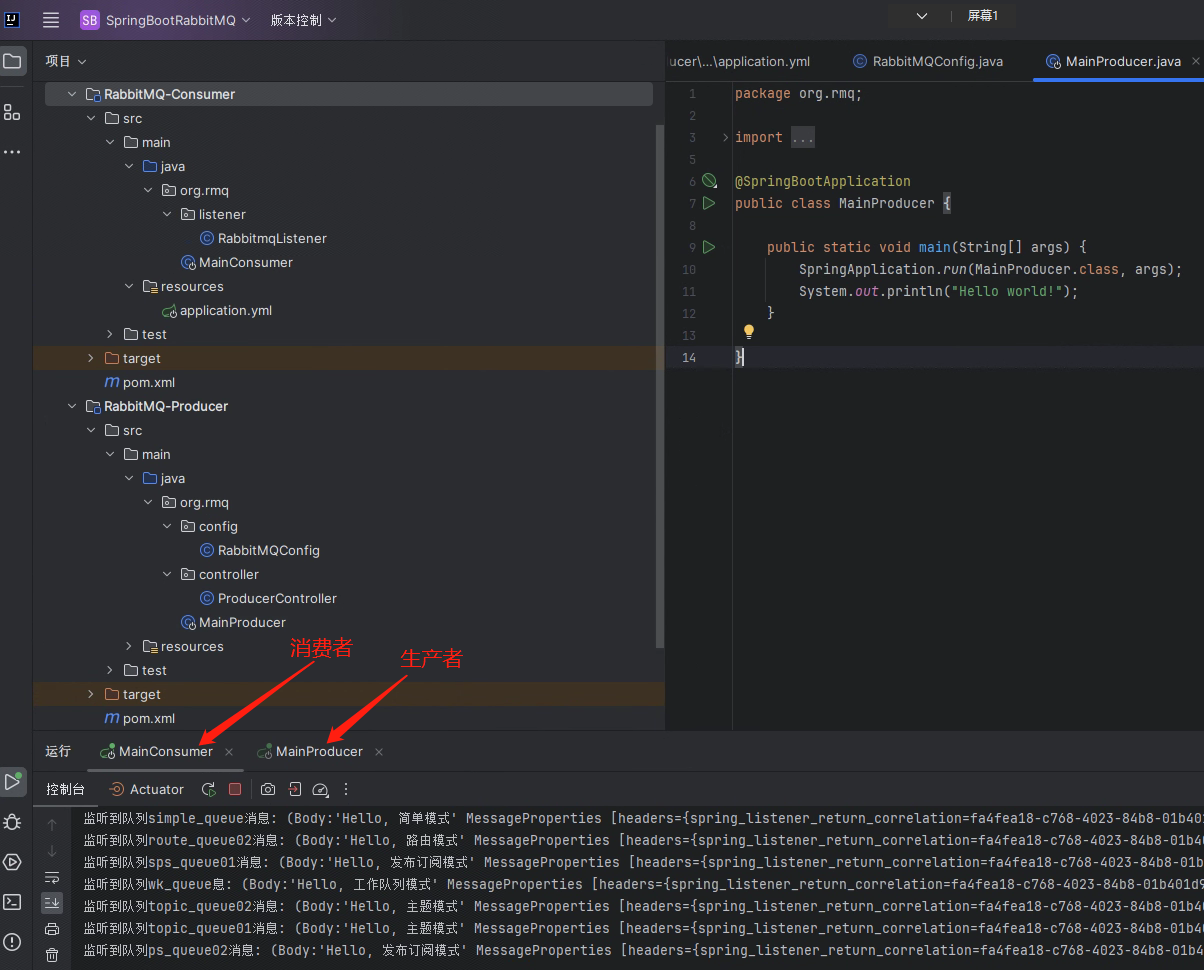
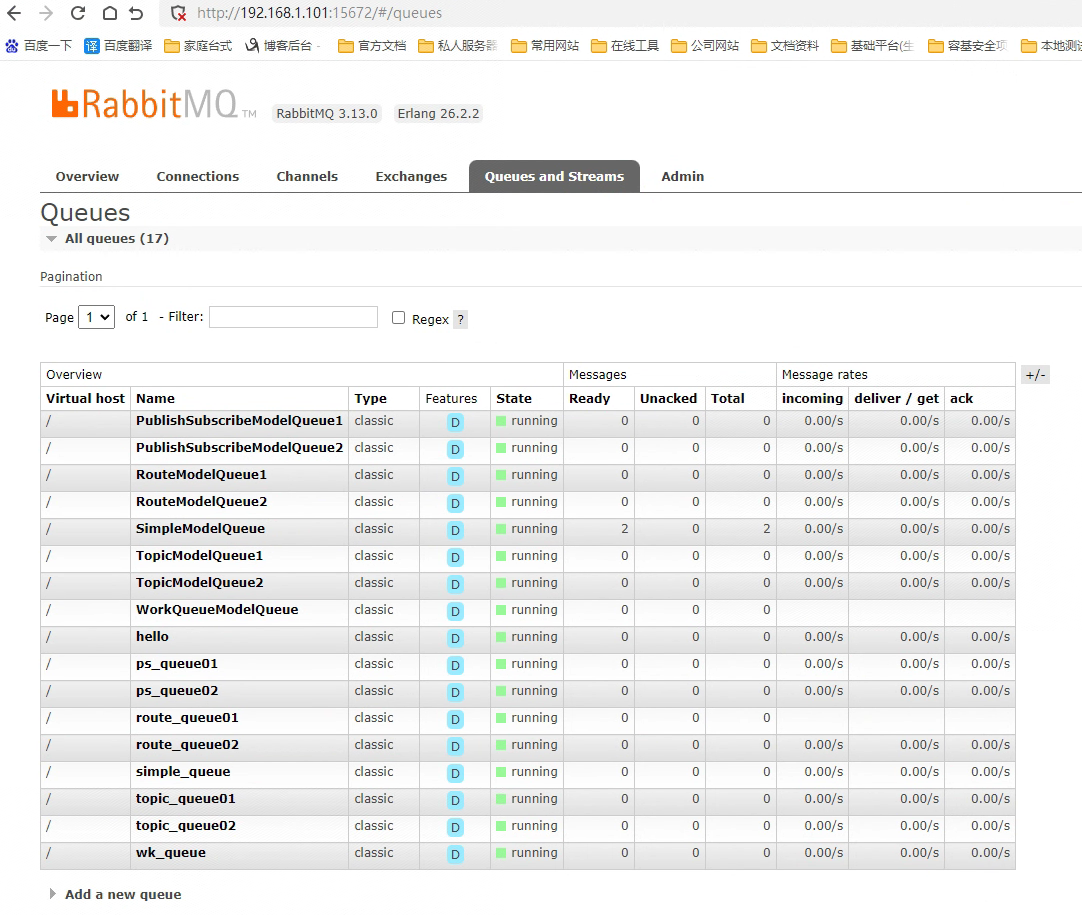







【推荐】国内首个AI IDE,深度理解中文开发场景,立即下载体验Trae
【推荐】编程新体验,更懂你的AI,立即体验豆包MarsCode编程助手
【推荐】抖音旗下AI助手豆包,你的智能百科全书,全免费不限次数
【推荐】轻量又高性能的 SSH 工具 IShell:AI 加持,快人一步
· TypeScript + Deepseek 打造卜卦网站:技术与玄学的结合
· Manus的开源复刻OpenManus初探
· AI 智能体引爆开源社区「GitHub 热点速览」
· C#/.NET/.NET Core技术前沿周刊 | 第 29 期(2025年3.1-3.9)
· 从HTTP原因短语缺失研究HTTP/2和HTTP/3的设计差异